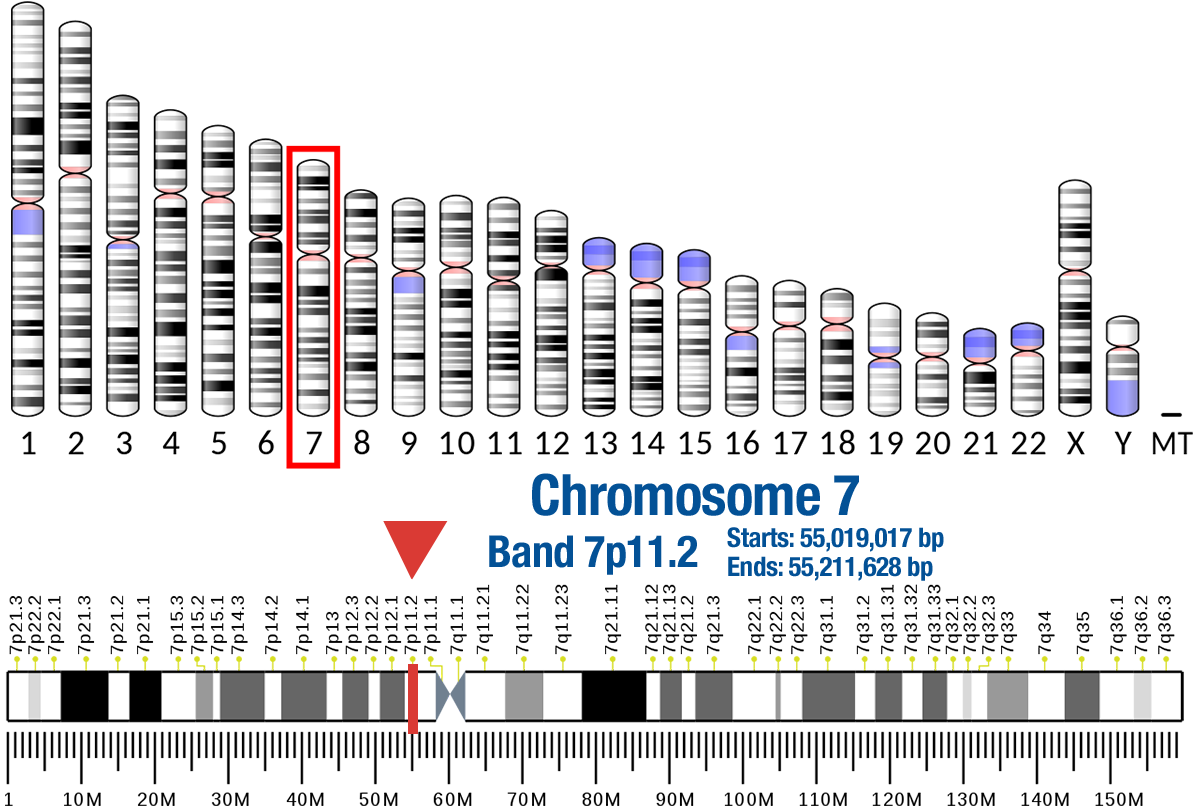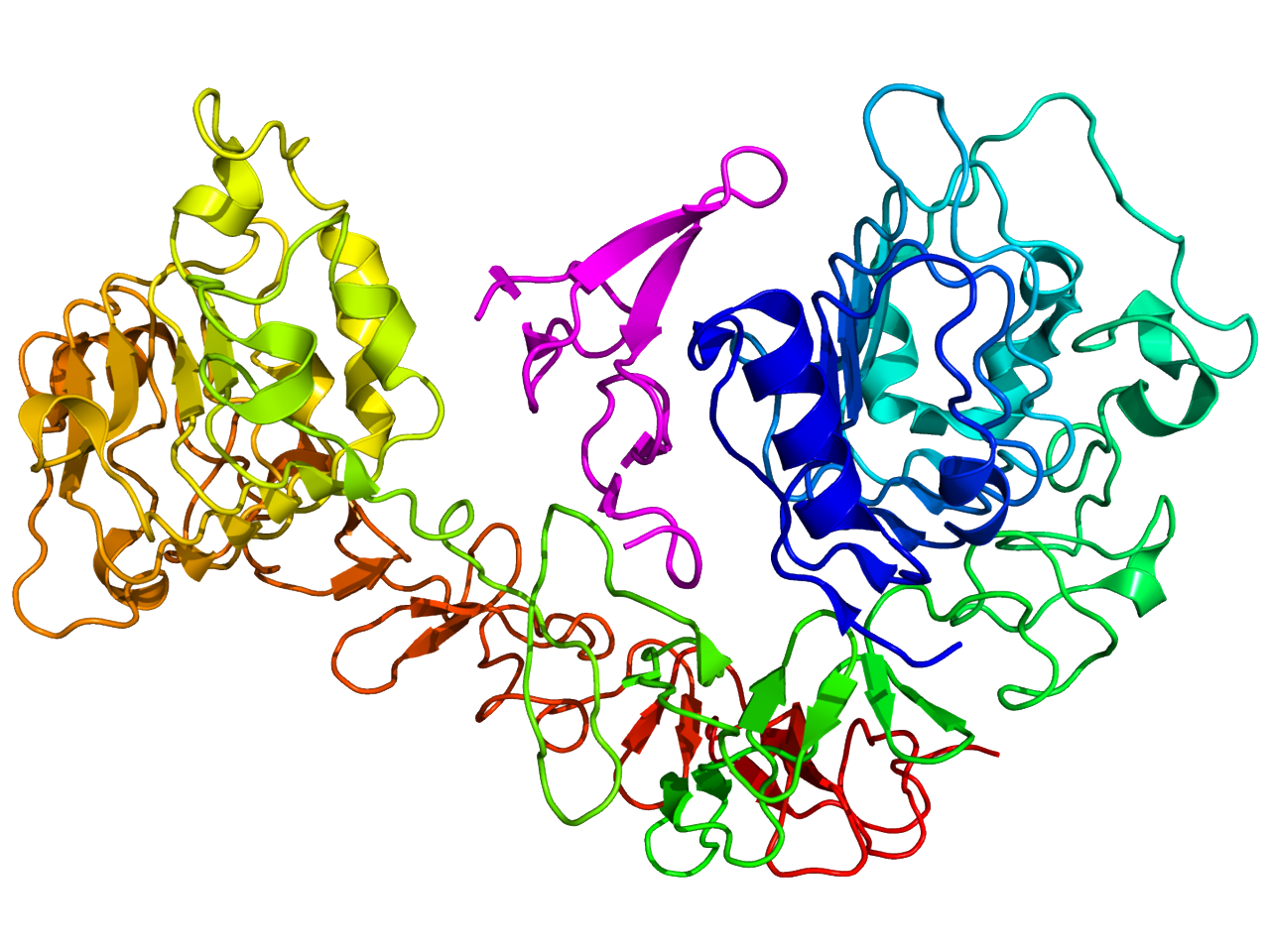
The protein encoded by this gene is a transmembrane glycoprotein that is a member of the protein kinase superfamily. This protein is a receptor for members of the epidermal growth factor family. EGFR is a cell surface protein that binds to epidermal growth factor, thus inducing receptor dimerization and tyrosine autophosphorylation leading to cell proliferation. Mutations in this gene are associated with lung cancer. EGFR is a component of the cytokine storm which contributes to a severe form of Coronavirus Disease 2019 (COVID-19) resulting from infection with severe acute respiratory syndrome coronavirus-2 (SARS-CoV-2). [provided by RefSeq, Jul 2020]
- Nucleotide binding
- Enables virus receptor activity
- Enables chromatin binding
- Enables double-stranded DNA binding
- Protein kinase activity
- Located in Golgi membrane
- Extracellular region
- Located in extracellular space
- Located in nucleus
- Located in cytoplasm
- Involved in MAPK cascade
- Involved in cell morphogenesis
- Involved in ossification
- Involved in embryonic placenta development
- Involved in positive regulation of protein phosphorylation
Receptor tyrosine kinase binding ligands of the EGF family and activating several signaling cascades to convert extracellular cues into appropriate cellular responses (PubMed:2790960, PubMed:10805725, PubMed:27153536). Known ligands include EGF, TGFA/TGF-alpha, AREG, epigen/EPGN, BTC/betacellulin, epiregulin/EREG and HBEGF/heparin-binding EGF (PubMed:2790960, PubMed:7679104, PubMed:8144591, PubMed:9419975, PubMed:15611079, PubMed:12297049, PubMed:27153536, PubMed:20837704, PubMed:17909029). Ligand binding triggers receptor homo- and/or heterodimerization and autophosphorylation on key cytoplasmic residues. The phosphorylated receptor recruits adapter proteins like GRB2 which in turn activates complex downstream signaling cascades. Activates at least 4 major downstream signaling cascades including the RAS-RAF-MEK-ERK, PI3 kinase-AKT, PLCgamma-PKC and STATs modules (PubMed:27153536). May also activate the NF-kappa-B signaling cascade (PubMed:11116146). Also directly phosphorylates other proteins like RGS16, activating its GTPase activity and probably coupling the EGF receptor signaling to the G protein-coupled receptor signaling (PubMed:11602604). Also phosphorylates MUC1 and increases its interaction with SRC and CTNNB1/beta-catenin (PubMed:11483589). Positively regulates cell migration via interaction with CCDC88A/GIV which retains EGFR at the cell membrane following ligand stimulation, promoting EGFR signaling which triggers cell migration (PubMed:20462955). Plays a role in enhancing learning and memory performance (By similarity). EGFR_HUMAN,P00533
- Inflammatory Skin And Bowel Disease, Neonatal, 2
- Lung Cancer
- Lung Cancer Susceptibility 3
- Lung Squamous Cell Carcinoma
- Giant Cell Glioblastoma
- Gliosarcoma
- Neonatal Inflammatory Skin And Bowel Disease
- Cowden Syndrome 1
- Brain Stem Glioma
- Brain Cancer
- Adenosquamous Carcinoma
- Adenocarcinoma
- Endometrial Adenocarcinoma
- Vulva Cancer
- Oral Cavity Cancer
- Squamous Cell Carcinoma
- Bile Duct Cancer
- Oligodendroglioma
- Adenosquamous Lung Carcinoma
- Glioblastoma
- Bronchiolo-Alveolar Adenocarcinoma
- Penile Cancer
- Salivary Gland Carcinoma
- Anaplastic Astrocytoma
EGFR Localizations – Subcellular Localization Database
The protein encoded by this gene is a transmembrane glycoprotein that is a member of the protein kinase superfamily. This protein is a receptor for members of the epidermal growth factor family. EGFR is a cell surface protein that binds to epidermal growth factor, thus inducing receptor dimerization and tyrosine autophosphorylation leading to cell proliferation. Mutations in this gene are associated with lung cancer. EGFR is a component of the cytokine storm which contributes to a severe form of Coronavirus Disease 2019 (COVID-19) resulting from infection with severe acute respiratory syndrome coronavirus-2 (SARS-CoV-2). [provided by RefSeq, Jul 2020]
- Nucleotide binding
- Enables virus receptor activity
- Enables chromatin binding
- Enables double-stranded DNA binding
- Protein kinase activity
- Located in Golgi membrane
- Extracellular region
- Located in extracellular space
- Located in nucleus
- Located in cytoplasm
- Involved in MAPK cascade
- Involved in cell morphogenesis
- Involved in ossification
- Involved in embryonic placenta development
- Involved in positive regulation of protein phosphorylation
Receptor tyrosine kinase binding ligands of the EGF family and activating several signaling cascades to convert extracellular cues into appropriate cellular responses (PubMed:2790960, PubMed:10805725, PubMed:27153536). Known ligands include EGF, TGFA/TGF-alpha, AREG, epigen/EPGN, BTC/betacellulin, epiregulin/EREG and HBEGF/heparin-binding EGF (PubMed:2790960, PubMed:7679104, PubMed:8144591, PubMed:9419975, PubMed:15611079, PubMed:12297049, PubMed:27153536, PubMed:20837704, PubMed:17909029). Ligand binding triggers receptor homo- and/or heterodimerization and autophosphorylation on key cytoplasmic residues. The phosphorylated receptor recruits adapter proteins like GRB2 which in turn activates complex downstream signaling cascades. Activates at least 4 major downstream signaling cascades including the RAS-RAF-MEK-ERK, PI3 kinase-AKT, PLCgamma-PKC and STATs modules (PubMed:27153536). May also activate the NF-kappa-B signaling cascade (PubMed:11116146). Also directly phosphorylates other proteins like RGS16, activating its GTPase activity and probably coupling the EGF receptor signaling to the G protein-coupled receptor signaling (PubMed:11602604). Also phosphorylates MUC1 and increases its interaction with SRC and CTNNB1/beta-catenin (PubMed:11483589). Positively regulates cell migration via interaction with CCDC88A/GIV which retains EGFR at the cell membrane following ligand stimulation, promoting EGFR signaling which triggers cell migration (PubMed:20462955). Plays a role in enhancing learning and memory performance (By similarity). EGFR_HUMAN,P00533
- Inflammatory Skin And Bowel Disease, Neonatal, 2
- Lung Cancer
- Lung Cancer Susceptibility 3
- Lung Squamous Cell Carcinoma
- Giant Cell Glioblastoma
- Gliosarcoma
- Neonatal Inflammatory Skin And Bowel Disease
- Cowden Syndrome 1
- Brain Stem Glioma
- Brain Cancer
- Adenosquamous Carcinoma
- Adenocarcinoma
- Endometrial Adenocarcinoma
- Vulva Cancer
- Oral Cavity Cancer
- Squamous Cell Carcinoma
- Bile Duct Cancer
- Oligodendroglioma
- Adenosquamous Lung Carcinoma
- Glioblastoma
- Bronchiolo-Alveolar Adenocarcinoma
- Penile Cancer
- Salivary Gland Carcinoma
- Anaplastic Astrocytoma
EGFR Localizations – Subcellular Localization Database
Gene Location



